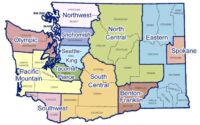Washington’s Workforce Development Boards:
How They Connect Employers to Job Seekers
By Kellie Hale
What are Workforce Development Boards (WDBs)? I kept hearing about them during my time at the CoE-HSEM. However, I never had the chance to interact with them personally or professionally. It wasn’t until I began working at Pacific Mountain (PacMtn) Workforce Development Council that I began to have a better understanding of WDBs. As a part of the Public Workforce System, WDBs are a network of federal, state, and local offices designed/functioned to support the expansion and development of talent that benefits the workforce and economy. For state and local WDBs, it provides a connection between the U.S. Department of Labor and local American Job Centers (sometimes referred to as WorkSource).
Workforce development connects employers and job seekers by creating a pipeline of skilled and talented workers prepared to meet the needs of local employers and industries of tomorrow. PacMtn oversees the regional network of American Job Centers called WorkSource, which house the demand-driven and integrated system of partners dedicated to developing community prosperity, one job seeker and one employer at a time.
In Washington State, there are twelve (12) local workforce development areas: 1.) Olympic Consortium Workforce Development Council, 2.) Pacific Mountain Workforce Development Council, 3.) Northwest Workforce Council, 4.) Workforce Snohomish, 5.) WorkForce Central, 6.) Workforce Development Council of Seattle – King County, 7.) North Central Workforce Development Council, 8.) South Central Workforce Council, 9.) Workforce Southwest Washington, 10.) Eastern Washington Partnership, 11.) Benton-Franklin Workforce Development Council, and 12.) Spokane Workforce Council.

The WDBs will work with local partners and collaborators on best practices to develop regional strategic plans and areas where funding is a priority. At PacMtn and other WDBs, we strive to facilitate strong partnerships between local businesses seeking training needs for potential employees or individuals looking to gain work experience. “Existing programs and available jobs can be leveraged to mitigate worker displacement by using data to identify trends to provide individuals with the best information on career pathways, and invest in what works.” Labor market information is relied on to develop strategies for specific industry sectors displaying growth in a region. This will result in a need for skill training for local businesses and employees. Representations from local businesses and community colleges are essential, along with elected officials, workforce program leaders, and other training providers. A solid and diverse community of partners ensures that WDBs meet the needs of the region and help maximize equitable opportunities for Washingtonians.

